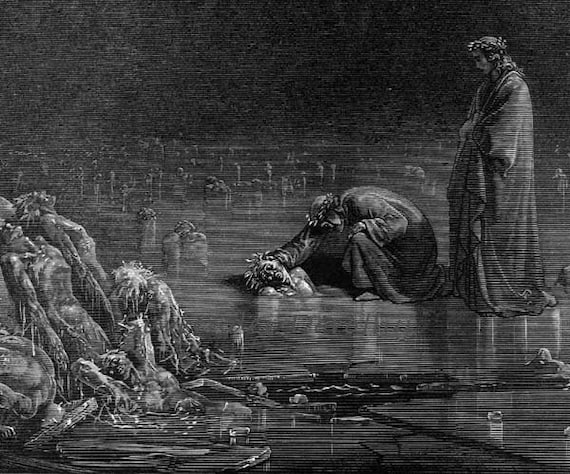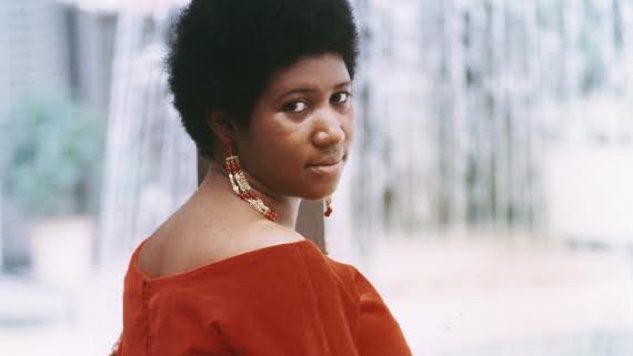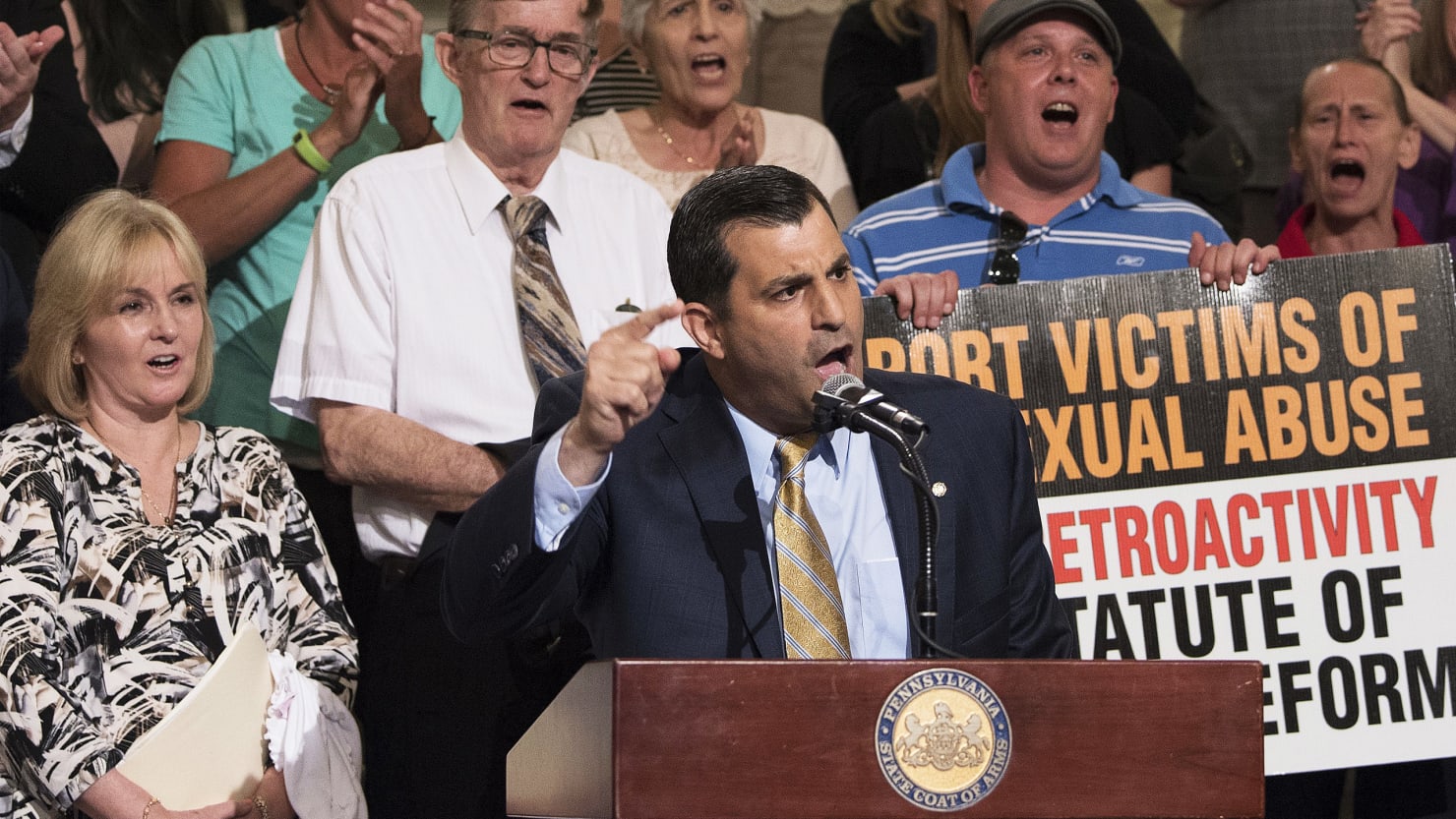By
August 17, 2018

Dante visiting traitors in Hell by Paul Gustave Dore'
The Catholic writer and activist Austin Ruse and I go way back, though our paths separated at some point after 2002, when I started writing about the abuse scandal.Austin tells that story in a column for Crisis:
And so on. More:Then 2002 came, and Rod started reporting on the priest sex scandal. Many of us thought Rod was going too far, going off the deep end, pulling out his hair. Like many others, I just could not believe some of the things we were hearing. What’s more, I instinctively thought that the bishops were doing, if not the right thing, then the thing that made sense given who they felt they had to listen to: insurance companies, lawyers, and psychologists.I just could not believe that Cardinal Law, for instance, was the bad guy. I just could not believe that such a friend to the pro-life movement was an enemy. I thought this was almost certainly the devil’s way of ridding us of such a valuable ally.I believed the bishops had to protect the Church, that the lawyers were probably right to offer compensation to victims and require them to keep quiet so as not to scandalize the faithful.
I recall perhaps the last time I was with Rod. It was at some conference years ago, still in the shadow of ‘02. I don’t remember where. We sat at a table along with Robert Royal and David Mills, and we talked about this issue. I don’t remember the exact conversation, but it was strained. There was already an estrangement over this issue and what he was doing. At that time, as we have come to know, Rod was under severe pressure from influential Catholic laymen and from important bishops to lay off. Father Neuhaus actually yelled at him. You are hurting the Church, they told him. This will blow over. This is being handled. Handled. Yes.Rod explained all along that he had stories, horrible and sickening stories that he could not report because no one would go on the record. We now know that one of the stories was about the crimes of then Cardinal McCarrick. When the McCarrick story broke a few weeks ago, I was surprised to discover in the New York Times that one of the heroes in the McCarrick story was one of my old spiritual directors, Fr. Boniface Ramsey, then pastor of St. Vincent Ferrer on Manhattan’s Upper East Side. Fr. Ramsey had gone to Cardinal Egan, Cardinal O’Malley, and the Vatican and no one did anything. Ramsey went to a frustrated Dreher, too, but he would not go on the record.My casual friendship with Rod was never the same again. And at this remove, I can say this: Rod was right, and I was wrong.
Austin goes on to say that in recent years, he finally came to understand that as far as the bishops are concerned, they’re on the inside, and to hell with the Catholic laity. More:
So, all those years ago, Rod was right, and I was wrong, and now I say this to Rod: Pedal to the metal. Tell it all. Tell it loud. Tell it long. Let the chips and even the prelates fall where they may.
What an extraordinary statement. Thank you, Austin Ruse. It wasn’t necessary, which is why I’m all the more grateful for it.
At the risk of oversharing, the most painful thing about covering the scandal from 2002 until I left the Catholic Church in 2006 was losing my Catholic faith, which had been at the center of my life since my conversion in 1993. But it was also losing a world I had loved, and in which I had many friendships. Some of those friendships ended when I left the Catholic Church, and others remained intact, but weren’t what they had been. Folks felt that I had betrayed them somehow.
And then there were the Catholics who did not know me, but wrote to condemn me, often viciously. These were in some cases the same Catholics who, for the previous three years, had been e-mailing me with awful stories of clerical sexual corruption in their own parishes or dioceses, urging me to DO SOMETHING ABOUT IT — but of course they wouldn’t put themselves on the line by going on the record, which is the only way that I or any journalist could have done something about it. I confess that I carried a lot of resentment back then against those people. Had they spent even one day dealing with the details of what journalists like me were dealing with, the evil would have fried their minds. I’ve often compared doing this kind of work to that scene from The Lord Of The Ringswhen Pippin stares at the Eye of Sauron through the Palantir, and it overwhelms him.
It overwhelmed me too, eventually, and my Catholic faith finally collapsed. Most of you know this story. What’s worth pointing out is that the final straw was realizing that my wife and I could not trust the institution anymore.
The particular moment, as I’ve written, was when we discovered by accident in the summer of 2004 that a priest we had come to like, Father Christopher Clay (whose name, by the way, is in the Pennsylvania grand jury report), was not who he said he was. He was not a faithful conservative priest who had been exiled by chancery liberals in the Diocese of Scranton, but was in fact a priest who had been suspended by his bishop after a complaint of sexual abuse stemming from his peripheral involvement in the homosexual traditionalist cult called the Society Of St. John. He had come to Dallas, his hometown, and been given work off the books by a priest in a conservative parish in the Diocese of Fort Worth.
That pastor did not tell his bishop that he had put Father Clay to work in the parish, because the bishop would not have allowed it, as it went against the Dallas charter. Neither the pastor nor the parish council informed the congregation, either. I told most of that story in this Dallas Morning News column. That event was the final one for my wife and me, because it told us that we couldn’t trust our own judgment. We thought the charismatic Father Clay was for real, and we had come to believe that we were so worldly wise that we could spot these frauds a mile away. We had come to believe that this parish, which we drove 45 minutes to get to on Sunday morning, was a safe haven, because they were openly and joyfully orthodox. And of course we believed that the Dallas Charter would weed out the bad actors; it hadn’t occurred to us that a parish pastor would withhold the truth from his bishop for the sake of putting an accused sex abuser into informal ministry.
I received back then an angry e-mail from a young man who was a member of the parish council, denouncing me for my betrayal, saying that of course the parish council knew about Father Clay, but didn’t see why it was the business of the congregation to know too.
We had two little boys back then. The safety of our children did not matter to these people. Only the protection of their churchy façade. And because we had allowed Father Clay into our family’s life, and indeed were at the point in our developing friendship where we were planning to start having him over for dinner, my wife and I had to face the fact that for all our vigilance, we couldn’t protect the boys either. We were gullible marks too, like so many other Catholic families who wanted to believe the best. And I had seen from my work on these cases what bishops and the legal machinery working for them do to victims and their families. We would have been no different.
We didn’t leave the Catholic Church then. In fact, we went back to our old parish, but by that point we were zombies. Spiritually, we were the walking dead. Our ability to trust was gone — and within a year, so were we.
In Dante’s Inferno, the deepest level of Hell is reserved for traitors. The reason for this is that Dante lived in a time and place where cities were at war with each other. Cities like Florence, Siena, and others surrounded themselves with walls, and closed the gates at night so people could sleep in peace. Traitors were an existential threat to those cities. If they unlocked the gates at night while everyone was resting in shared trust, all would be lost. Shared trust was the thing that made common life possible. Traitors were a mortal threat to that life.
This is what finally drove us out of the Catholic Church: the treason of the clerics — especially the bishops.
It is true that the sins of the clergy do not negate the truths proclaimed by the Catholic Church, or any church. But that rigorous logic is hard to live by when you’re raising children, or at least I found it to be true. To continue as a Catholic would have meant having to live with a total lack of trust in the clergy — and not only bishops. We knew good priests, and counted them as among our dearest friends (still do), but as the Father Clay incident showed us, we were still susceptible to manipulation — and even “good conservatives” in the clergy and in lay leadership were satisfied to mislead congregations to protect what they had.
In New York, when I was at National Review, I received a phone call from Brooks Egerton, a Dallas Morning News reporter trying to interview Father Benedict Groeschel for an abuse story. Egerton wanted to get Groeschel’s side of the story, and to clarify some things. He told me that Groeschel wasn’t responding to his repeated phone messages. Egerton, whom I did not know personally, cold-called me hoping that I could convince Groeschel to return his calls. I had no relationship with Groeschel, and I had gone from having been an admirer of his, pre-scandal, to seeing him as a much darker figure, one who had recycled abusers through his treatment center. Egerton eventually tired of seeking comment from Groeschel, and published his story.
Groeschel, in turn, had a public conniption, and wrote something denouncing the piece. Excerpt:
I did not decline to be interviewed. I never spoke to Mr. Egerton because I was not at home when he called. After this article I am grateful to God I did not talk to him. … Mr. Egerton’s article is a prime example of the hostility, distortion and planned attack on the Catholic Church in the United States by certain segments of the media.
This was a complete, self-serving lie. Father Groeschel, who died a few years ago, smeared a journalist to protect his reputation. All the errors that Groeschel claims were in Egerton’s story could have been clarified had Groeschel simply taken Egerton’s phone call. This infuriated me, in part because I knew that Benedict Groeschel, famous for his appearances on EWTN, had such a sterling reputation among conservative Catholics that they would accept his word at face value.
By no means do I believe that all priests are deceivers. I don’t believe that for a second. Some of the finest men I know are priests. My point here is simply that having to live at that level of suspicion about priests in general, and having to raise kids in a church environment in which I taught them, for their own good, to distrust the clergy in general before they learned to trust the clergy — well, it was more than my wife and I could manage.
To continue on as Catholics would have meant accepting that the bishops were going to get away with their lies, and were not going to be held accountable for what they had done. Cardinal McCarrick was the chief example for me. I had known about him since 2002, but couldn’t report what I knew to be true because none of my sources would go on the record. I knew him to be an outrageous liar. He had sicced an elite conservative friend of his to intercede with my editor at the time to get me off the story of his molesting seminarians. My editor refused, but in the end, without documents or people willing to go on the record, I had no story. Yet there was McCarrick, always in the media presenting himself as a good guy, one who could be trusted to clean up the scandal.
It was all a lie. Every bit of it.
To immerse oneself in the details of the scandal was to confront the terrible fact that bishops lied as a matter of course, and justified it as “for the good of the Church.” Even good bishops. Even today. Anybody who believes that Cardinal Donald Wuerl and Cardinal Kevin Farrell had no idea at all about McCarrick’s depredations is a fool. Even if they happen to be telling the truth, to take them at their word is a sucker’s bet.
As I said above, it is not the case that the truth claims of the Church are negated by the wickedness of the clergy. But it is very much the case that the wickedness of the clergy can make it difficult to take those truth claims seriously, or to hold on to them. My wife and I reached the point where we no longer believed that our salvation depended on being in communion with the Catholic Church. It’s hard for faithful Catholics to imagine getting to that place. It would have been next to impossible for us to imagine at any time before 2002 that we would be in that place. But there we were. And then we weren’t.
When I am asked about this in public events, I try to stay focused on things I could have done to have strengthened myself in my Catholic faith during this trial. I am grateful to God to be an Orthodox Christian, but I wish my conversion had been “clean” — that is, made in perfect serenity and rationality, instead of being like a drowning man grabbing the only lifeline visible. My Orthodox faith would be no more secure if I made the same mistakes I had made as a Catholic. I encourage all Catholics — and Orthodox, and Protestants alike — to strengthen themselves by going much deeper into the faith through simple but habitual acts of faith. My greatest error was assuming that as long as I affirmed all the right doctrines intellectually, that my faith would be unassailable. It’s not true. My conversion was always more precarious than I realized, because while my head was converted, my heart was not, or at least not as strongly as it needed to be.
I don’t tell Catholics to leave the Catholic Church. I do warn Catholics that if you are going to hold on through this trial, you are going to have to live your faith differently. As a Catholic, I had long thought about what I was prepared to suffer for the sake of the Church, if a time of persecution came upon us. I had never once prepared myself to suffer from the Church.
To end: I’m truly surprised by my friend Austin Ruse’s column, and grateful for it — not in an “I told you so” sense, but because of the hope that it represents: hope that finally, some of the most stalwart Catholics are waking up to the fact that they have traitors in their midst, and are prepared to do something about it.
Dante has traitors encased in a lake of ice in the ninth circle of Hell. He does this to represent the severing of all human bonds effected by their treason. Theirs was not a crime of passion, but one of cold deliberation. This is why the deeds of the bishops and their abettors, including prominent priests and laymen, were more damaging to my own faith than the vile sins of the sex-abusing clergy: because bishops were not driven by demonic passions. They could have stopped these evil priests, and thrown them out of the priesthood forever. They didn’t do so. Their hearts were cold towards victims and the laity, and they made their decisions to protect evildoers with stone-cold rationality. For them, it was just business.
Posted in Christianity. Tagged Catholicism, sex abuse, Benedict Groeschel, bishops, Dante, traitors,Austin Ruse.


